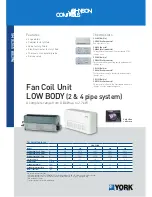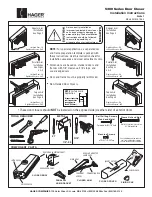
- 5 -
INDUCTION HEATING SYSTEM FOR PROFESSIONAL USE IN BODY SHOPS AND
REPAIR SHOPS.
Note: In the text that follows the term “heating machine” indicates the complete
machine, while the term “inductor” indicates only the tool being used.
1. GENERAL SAFETY FOR INDUCTION HEATING
The operator must be sufficiently trained on how to use the heating machine
safely, and be informed on the risks connected with the induction heating
process, the relative protection measures and the emergency procedures.
- The heating tools can be connected and checks and repairs be carried out
only after the machine has been switched off and disconnected from the
mains.
- Switch off the machine and disconnect it from the mains before replacing
worn tool parts.
- Carry out electric installation as indicated by relevant regulations and
accident prevention laws.
- The heating machine must be connected only and exclusively to a power
supply with the neutral conductor connected to earth.
- Make sure that the power supply outlet is correctly connected to the earth
conductor.
- Do not use the heating system under damp or wet environments or in the rain.
- Do not use cables with deteriorated insulation or loose connections.
- Never look into the inside of the machine (and only then for extraordinary
maintenance) unless you are completely satisfied that:
- machine switch is at “O”;
- automatic main switch is at “O” and locked with key or, if there is no key lock,
make sure that the power cable terminals are disconnected;
- given the presence of capacitors, the power source has been switched off for
at least 5 minutes before starting maintenance work.
- Do not heat containers, receptacles or piping that contain or have contained
inflammable liquids or gases.
- Do not work on materials cleaned with chlorinated solvents or in the vicinity
of such substances.
- Do not heat pressurised containers.
- Remove all inflammable substances (e.g. wood, paper, rags etc.) from the
working area.
- In order to reduce the production of smoke during heating, we recommend
cleaning the pieces first (e.g. pieces that are soiled with lubricants or thinners).
- The smoke produced during heating can be toxic. Wear suitable breathing
equipment with a mask suitable for powder and smoke (double filter).
- Work in a well-ventilated area.
- Always protect the eyes. Use special fire-resistant protective clothing.
- The heating machine can increase the temperature of metal very quickly: do
not touch the hot piece with bare hands and wait for it to cool before handling
it.
- Make sure there is adequate electrical insulation with respect to the workpiece.
This can normally be done by wearing gloves, and the clothing indicated for
this purpose.
- The passage of current into the output circuit generates electromagnetic
fields (EMF) around the tool being used.
The electromagnetic fields can interfere with some medical devices (e.g.
Pacemaker, breathing systems, metal prostheses, etc.).
Suitable protective measures for those who use these devices must be taken.
As an example, prohibit access to the heating machine use area.
This machine satisfies the product technical standards for exclusive use
in industrial environments for professional purposes. Compliance to the
basic limits regarding human exposure to electromagnetic fields cannot be
guaranteed in a domestic environment.
The operator must use the following procedures in order to reduce exposure to
electromagnetic fields:
- Keep the head and chest as far as possible from the inductor.
- Never wind the inductor cable around the body.
- During heating, keep at least 50 cm away from the generator.
- When the inductor is active it generates strong electromagnetic fields that
cannot be seen at the extremities. The inductor must be exclusively facing
the metal parts to be heated: do not direct the inductor towards parts of the
human body!
- Do not wear metal objects, watches, rings, piercing, etc. because the inductor
can heat metal very quickly, causing burns.
- Do not wear clothing with metal zips, metal buttons or metal trims of any kind
because the inductor can heat metal very quickly, creating burns and causing
the clothing to catch fire.
- Minimum distance d= 20 cm (Fig. P).
- Class A equipment:
This machine satisfies the requirements of the product technical standards
for exclusive use in industrial environments for professional purposes.
Electromagnetic compatibility in domestic buildings and in those directly
connected to a low voltage mains network that supplies domestic buildings is
not guaranteed.
ADDITIONAL PRECAUTIONS
- Do not heat the inductor near or against the generator.
- Do not use the inductor near car “AIRBAGS”. Keep the inductor at least 10 cm
away from airbags: the heat generated by the system can cause the airbag to
ignite without warning. Refer to the vehicle manual for the exact position of
the airbags.
RESIDUAL RISKS
- The person entrusted to carry out the work must be suitably trained in the
induction heating process with this specific type of machine.
- People unconnected with the job must not be allowed in the working area.
- Do not allow more than one person to work on the machine at the same time.
- IMPROPER USE: it is dangerous to use the machine for any purpose other
than the one indicated.
2. INTRODUCTION AND GENERAL DESCRIPTION
Mobile system for the local induction heating of metal parts made from steel specifically
for vehicles.
The machine was designed and built mainly for:
- removing logos, adhesives, mouldings, plastic and rubber parts glued to the panels.
- releasing rusty nuts and bolts and rusty door hinges;
- tempering panels;
- repairing small dents in panels;
- quickly removing the windscreen, rear window, and glued side windows from the
vehicle.
2.1 MAIN CHARACTERISTICS:
- Automatic recognition of the tool being used.
- Choice of “MAN” (manual) or “AUTO” (automatic) heating power adjustment.
- LED bar that displays the power transferred to the piece.
- Acoustic signal proportional to the power transferred to the piece.
- Automatic recognition of the piece to be heated.
- Visualisation on display of the machine functions (tool being used, power adjustment
percentage, alarms).
2.2 ACCESSORIES (FIG. D)
a- Glass remover
b- Bolt releaser.
c- Heating pad.
d- Foot control.
e- Lever kit for glass remover.
f- Non-scratch protective strips.
g- Heating pen.
h- Confined field glass remover
i- Heat Twister.
l- Trolley.
Other accessories can be indicated in the Products catalogue.
3. TECHNICAL DATA
The main information about use and performance of the machine is given briefly on the
rating plate (back panel) and has the following meanings:
FIG. A
1- Manufacturer
2- IP protection rating
3- Power line symbol.
4- Predicted heating process symbol
5- Output circuit performance:
- U
2
: output voltage.
- I
2
: output current.
- f
2
: output frequency.
- P
2
max : maximum output power.
6- Characteristic data of the supply line:
ENGLISH
INDEX
1. GENERAL SAFETY FOR INDUCTION HEATING ................................................5
2. INTRODUCTION AND GENERAL DESCRIPTION ...............................................5
2.1 MAIN CHARACTERISTICS: ............................................................................5
2.2 ACCESSORIES (FIG. D) ..................................................................................5
3. TECHNICAL DATA ................................................................................................5
3.1 OTHER TECHNICAL DATA: .............................................................................6
4. MACHINE DESCRIPTION (FIG. B) .......................................................................6
4.1 CONNECTING, CONTROL AND ADJUSTMENT DEVICES ...........................6
4.2 SIGNALS AND ALARMS ..................................................................................6
5. INSTALLATION ......................................................................................................6
5.1 HEATING SYSTEM POSITION ........................................................................6
5.2 CONNECTION TO THE MAIN POWER SUPPLY ............................................6
5.2.1 Plug and socket .......................................................................................6
5.3 TOOL AND FOOT CONTROL CONNECTIONS (FIG. C).................................6
5.3.1 Tool connection .......................................................................................6
5.3.2 Connecting the foot control .....................................................................6
6. TOOL USE .............................................................................................................6
6.1 PRELIMINARY OPERATIONS .........................................................................6
6.2 OPERATING PRINCIPLE.................................................................................6
6.3 AUTO AND MANUAL MODE (FIG. B-3). ..........................................................6
6.4 USING THE GLASS REMOVER ......................................................................6
6.5 USING THE BOLT RELEASER ........................................................................6
6.6 USING THE HEATING PAD .............................................................................7
6.7 USING THE CONFINED-SPACE GLASS REMOVER ....................................7
6.8 USING THE HEATING PEN ............................................................................7
7. MAINTENANCE .....................................................................................................7
7.1 ROUTINE MAINTENANCE ..............................................................................7
7.2 EXTRAORDINARY MAINTENANCE ...............................................................7
8. TROUBLESHOOTING ...........................................................................................7
page
page
Содержание Smart Inductor 5000
Страница 26: ...26 7 1 7 2 O 5 10 8 I...
Страница 33: ...33 max 10 bar 8 I...
Страница 81: ...81 7 1 7 2 O O 5 max 10bar 8 I...
Страница 87: ...87 FIG D FIG E a b c l d e f g h i T Max sheet metal lamiera HEAT MAP MAPPA CALORE...






































